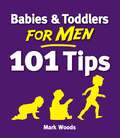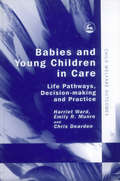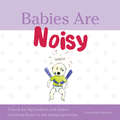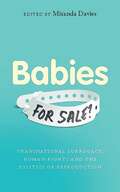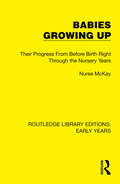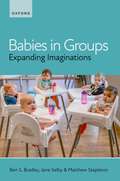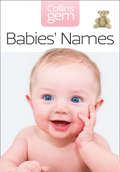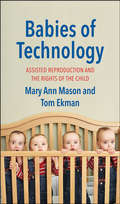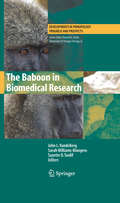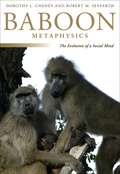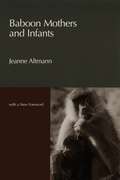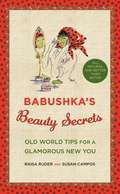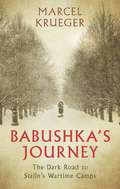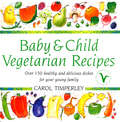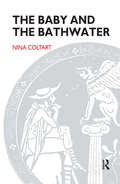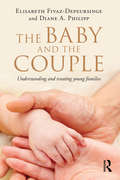- Table View
- List View
Babies and Toddlers for Men: 101 Tips
by Mark WoodsBecoming a father is a moment in a man's life like no other. The love, the pride, the joy and occasionally the fear stirred up inside us by the complex little being that moves into our home and our relationship takes some serious getting used to. And then there's the really tough stuff like putting up a travel cot and installing a car seat. Despite all this though we are often given more advice when we buy a phone than when we become a Dad...until now. This is the indispensable manual every new dad needs from newborn to nursery, this is Babies and Toddlers for Men. Written by Mark Woods, author of the best selling Pregnancy for Men and proud father of two, this utterly readable guide tells you how it is in a frank and funny way that will leave you educated and energised to take on the next amazing stage of being a Dad.
Babies and Young Children in Care: Life Pathways, Decision-making and Practice (PDF)
by Chris Dearden Emily Munro Harriet WardBabies and very young children in care often experience several changes of placement and carer, which can have a negative impact upon their long-term ability to develop secure attachments. Babies and Young Children in Care examines why babies enter care or accommodation and why securing their long-term future can be a lengthy process. It analyses the circumstances, characteristics and experiences of these young children before, during and after being looked after, including reasons for changes of carer and placement disruptions. It looks at how young children are affected by the lack of stability in their lives, and explores the consequences of reunification with their parents after long periods in care. Drawing on interviews with birth parents, carers and social care professionals, the authors trace the complex decision-making process that influences these children's early experiences and the impact this has on their later development and well-being. They offer a clear explanation of the outcomes of services for very young children and signpost messages for practice. This book is a key text for researchers, practitioners, policy makers and social care managers.
Babies Are Noisy: A book for big brothers and sisters including those on the autism spectrum (PDF)
by Anne-Marie HarrisonWhen Andre starts to notice Mummy's tummy getting bigger, it's the start of lots of changes for his family. My Baby is on his way and he's bringing lots of noise with him! This engaging illustrated children's book is ideal for preparing young children age 3+ on and off the autism spectrum for the arrival of a new brother or sister. Covering everything from trips to the hospital, what to expect when the baby arrives and the fun, family times to look forward to, 'Babies are Noisy' is mindful of how children with autism think, learn and experience the world and is full of strategies for coping with the sensory issues and routine changes that a new baby brings. Reflecting the real life situations that families with a child with autism find themselves faced with, this book can be read with parents and professionals to prepare the child for the arrival of their new sibling.
Babies for Sale?: Transnational Surrogacy, Human Rights and the Politics of Reproduction
by Miranda DaviesTransnational surrogacy – the creation of babies across borders – has become big business. Globalization, reproductive technologies, new family formations and rising infertility are combining to produce a 'quiet revolution' in social and medical ethics and the nature of parenthood. Whereas much of the current scholarship has focused on the US and India, this groundbreaking anthology offers a far wider perspective.Featuring contributions from over thirty activists and scholars from a range of countries and disciplines, this collection offers the first genuinely international study of transnational surrogacy. Its innovative bottom-up approach, rooted in feminist perspectives, gives due prominence to the voices of those most affected by the global surrogacy chain, namely the surrogate mothers, donors, prospective parents and the children themselves. Through case studies ranging from Israel to Mexico, the book outlines the forces that are driving the growth of transnational surrogacy, as well as its implications for feminism, human rights, motherhood and masculinity.
Babies for Sale?: Transnational Surrogacy, Human Rights and the Politics of Reproduction
by Miranda DaviesTransnational surrogacy – the creation of babies across borders – has become big business. Globalization, reproductive technologies, new family formations and rising infertility are combining to produce a 'quiet revolution' in social and medical ethics and the nature of parenthood. Whereas much of the current scholarship has focused on the US and India, this groundbreaking anthology offers a far wider perspective.Featuring contributions from over thirty activists and scholars from a range of countries and disciplines, this collection offers the first genuinely international study of transnational surrogacy. Its innovative bottom-up approach, rooted in feminist perspectives, gives due prominence to the voices of those most affected by the global surrogacy chain, namely the surrogate mothers, donors, prospective parents and the children themselves. Through case studies ranging from Israel to Mexico, the book outlines the forces that are driving the growth of transnational surrogacy, as well as its implications for feminism, human rights, motherhood and masculinity.
Babies Growing Up: Their Progress From Before Birth Right Through the Nursery Years (Routledge Library Editions: Early Years)
by Nurse McKayOriginally published in 1956, Babies Growing Up aims to compress in to a brief yet readable form, the essentials of successful parentcraft at the time, bearing in mind the four elements of developing a new life – physical, mental, emotional and spiritual. It seeks to sum up the essence of the mothercraft advice given over the years through the pages of Woman’s Pictorial and Mother and Home, where some material had appeared previously. It is a comprehensive guide through a baby’s life from birth through the early years and today can be enjoyed as a historical look at parenting and child development in the 1950s.
Babies Growing Up: Their Progress From Before Birth Right Through the Nursery Years (Routledge Library Editions: Early Years)
by Nurse McKayOriginally published in 1956, Babies Growing Up aims to compress in to a brief yet readable form, the essentials of successful parentcraft at the time, bearing in mind the four elements of developing a new life – physical, mental, emotional and spiritual. It seeks to sum up the essence of the mothercraft advice given over the years through the pages of Woman’s Pictorial and Mother and Home, where some material had appeared previously. It is a comprehensive guide through a baby’s life from birth through the early years and today can be enjoyed as a historical look at parenting and child development in the 1950s.
Babies in Groups: Expanding Imaginations
by Ben S. Bradley Jane Selby Matthew StapletonThis is an open access title available under the terms of a CC BY-NC-ND 4.0 International licence. It is free to read on the Oxford Academic platform and offered as a free PDF download from OUP and selected open access locations. Research has shown that young babies - well before they form their first bond to a caring adult - enjoy participating in groups and group processes. Babies in Groups examines the consequences of these findings for science, for early education practice and policy, and for adult psychotherapy. The authors report research showing the extensive capacity of preverbal infants for group-communication in all-baby trios and quartets, backed by findings about primate sociability, the social brain, cultural histories, and human evolution. These studies open up new ways of imagining human development as fundamentally group-based. In addition, the authors explore the changes that a group-based vision of infancy could bring to early child education and care. They also show how ignoring group contexts in many clinical traditions can distort descriptions of what happens in therapy, producing such unintended consequences as 'mother-blaming' for the future problems an infant may experience as she or he grows up. Finally, the book's appendix summarises the main forms of evidence which falsify claims that science has proven that an inborn gift for dyadic 'intersubjectivity,' or for one-to-one infant-adult attachments, founds human social development.
Babies in Groups: Expanding Imaginations
by Ben S. Bradley Jane Selby Matthew StapletonThis is an open access title available under the terms of a CC BY-NC-ND 4.0 International licence. It is free to read on the Oxford Academic platform and offered as a free PDF download from OUP and selected open access locations. Research has shown that young babies - well before they form their first bond to a caring adult - enjoy participating in groups and group processes. Babies in Groups examines the consequences of these findings for science, for early education practice and policy, and for adult psychotherapy. The authors report research showing the extensive capacity of preverbal infants for group-communication in all-baby trios and quartets, backed by findings about primate sociability, the social brain, cultural histories, and human evolution. These studies open up new ways of imagining human development as fundamentally group-based. In addition, the authors explore the changes that a group-based vision of infancy could bring to early child education and care. They also show how ignoring group contexts in many clinical traditions can distort descriptions of what happens in therapy, producing such unintended consequences as 'mother-blaming' for the future problems an infant may experience as she or he grows up. Finally, the book's appendix summarises the main forms of evidence which falsify claims that science has proven that an inborn gift for dyadic 'intersubjectivity,' or for one-to-one infant-adult attachments, founds human social development.
Babies in Groups
by Robert E. GoodinConsent works moral magic. Things that would otherwise be wrong to do to someone are, with that person's consent, made morally permissible. But what is consent, and how does it work? What can be taken for consent (perhaps wrongly) and with what consequences? How does consent come into being and pass out of it? How can consent be conferred, invoked and revoked? What is the role of social and legal norms in governing consent? How contextually sensitive should those norms be in applying to diverse settings, ranging from sexual encounters to prison hospitals to the poll booth? Those are the sorts of broad questions animating this book. It aspires to provide a comprehensive account of the social practice of consent, informed by deep reading in the history of ideas, philosophy, law, political science and sociology. Consent Matters thus serves, at one and the same time, as a guide for the perplexed social practitioner of consent and as a touchstone for philosophical attempts to theorize and to refine those existing practices.
Babies’ Names (Collins Gem)
by CollinsA brand-new edition of this best-selling guide to over 1,500 first names. Gem Babies’ Names gives the origins of each name, and also lists the most popular girls’ and boys’ names in Britain today. The ideal pocket guide to choosing a name for your baby.
Babies of Technology: Assisted Reproduction and the Rights of the Child
by Mary Ann Mason Tom EkmanMillions of children have been born in the United States with the help of cutting-edge reproductive technologies, much to the delight of their parents. But alarmingly, scarce attention has been paid to the lax regulations that have made the U.S. a major fertility tourism destination. And without clear protections, the unique rights and needs of the children of assisted reproduction are often ignored. This book is the first to consider the voice of the child in discussions about regulating the fertility industry. The controversies are many. Donor anonymity is preventing millions of children from knowing their genetic origins. Fertility clinics are marketing genetically enhanced babies. Career women are saving their eggs for later in life. And Third World women are renting their wombs to the rich. Meanwhile, the unregulated fertility market charges forward as a multi-billion-dollar industry. This deeply-considered book offers answers to the urgent question: Who will protect our babies of technology?
The Baboon in Biomedical Research (Developments in Primatology: Progress and Prospects)
by Suzette D. Tardif Sarah Williams-Blangero John L. VandeBergNonhuman primates have played critical roles in biomedical research, and they are among the few animals whose use in research continues to increase. The scienti?c value of nonhuman primates derives from their close phylogenetic proximity to man and their consequent anatomic, physiologic, and genetic similarities to man. Only nonhuman primates can provide adequate models for many complex physiological and disease processes of humans. The baboon is a relative newcomer to the repertoire of nonhuman primates used in biomedical research. However, in less than 50 years since its ?rst use in the U. S. , it has become one of the most popular laboratory primate species. It is larger than the other widely used monkey species, making it advantageous for many types of experiments and technological developments. It is extraordinarily hardy and highly fecund in captivity. It closely resembles humans in a variety of physiological and disease processes, such as cholesterol metabolism, early stages of atherosclerosis, and alcoholic liver disease. Its chromosomes closely resemble those of humans, and many genes of the two species lie in the same chromosomal order. Among all primates, baboons are the most widely used models for the genetics of susceptibility to complex diseases and they are the ?rst nonhuman primate for which a framework genetic linkage map was established. In addition, the baboon genome is currently being sequenced, and as a result the utility of this species for biomedical research will be dramatically increased.
Baboon Metaphysics: The Evolution of a Social Mind
by Dorothy L. Cheney Robert M. SeyfarthIn 1838 Charles Darwin jotted in a notebook, “He who understands baboon would do more towards metaphysics than Locke.” Baboon Metaphysics is Dorothy L. Cheney and Robert M. Seyfarth’s fascinating response to Darwin’s challenge. Cheney and Seyfarth set up camp in Botswana’s Okavango Delta, where they could intimately observe baboons and their social world. Baboons live in groups of up to 150, including a handful of males and eight or nine matrilineal families of females. Such numbers force baboons to form a complicated mix of short-term bonds for mating and longer-term friendships based on careful calculations of status and individual need. But Baboon Metaphysics is concerned with much more than just baboons’ social organization—Cheney and Seyfarth aim to fully comprehend the intelligence that underlies it. Using innovative field experiments, the authors learn that for baboons, just as for humans, family and friends hold the key to mitigating the ill effects of grief, stress, and anxiety. Written with a scientist’s precision and a nature-lover’s eye, Baboon Metaphysics gives us an unprecedented and compelling glimpse into the mind of another species. “The vivid narrative is like a bush detective story.”—Steven Poole, Guardian “Baboon Metaphysics is a distillation of a big chunk of academic lives. . . . It is exactly what such a book should be—full of imaginative experiments, meticulous scholarship, limpid literary style, and above all, truly important questions.”—Alison Jolly, Science “Cheney and Seyfarth found that for a baboon to get on in life involves a complicated blend of short-term relationships, friendships, and careful status calculations. . . . Needless to say, the ensuing political machinations and convenient romantic dalliances in the quest to become numero uno rival the bard himself.”—Science News “Cheney and Seyfarth’s enthusiasm is obvious, and their knowledge is vast and expressed with great clarity. All this makes Baboon Metaphysics a captivating read. It will get you thinking—and maybe spur you to travel to Africa to see it all for yourself.”—Asif A. Ghazanfar, Nature “Through ingenious playback experiments . . . Cheney and Seyfarth have worked out many aspects of what baboons used their minds for, along with their limitations. Reading a baboon’s mind affords an excellent grasp of the dynamics of baboon society. But more than that, it bears on the evolution of the human mind and the nature of human existence.”—Nicholas Wade, New York Times
Baboon Metaphysics: The Evolution of a Social Mind
by Dorothy L. Cheney Robert M. SeyfarthIn 1838 Charles Darwin jotted in a notebook, “He who understands baboon would do more towards metaphysics than Locke.” Baboon Metaphysics is Dorothy L. Cheney and Robert M. Seyfarth’s fascinating response to Darwin’s challenge. Cheney and Seyfarth set up camp in Botswana’s Okavango Delta, where they could intimately observe baboons and their social world. Baboons live in groups of up to 150, including a handful of males and eight or nine matrilineal families of females. Such numbers force baboons to form a complicated mix of short-term bonds for mating and longer-term friendships based on careful calculations of status and individual need. But Baboon Metaphysics is concerned with much more than just baboons’ social organization—Cheney and Seyfarth aim to fully comprehend the intelligence that underlies it. Using innovative field experiments, the authors learn that for baboons, just as for humans, family and friends hold the key to mitigating the ill effects of grief, stress, and anxiety. Written with a scientist’s precision and a nature-lover’s eye, Baboon Metaphysics gives us an unprecedented and compelling glimpse into the mind of another species. “The vivid narrative is like a bush detective story.”—Steven Poole, Guardian “Baboon Metaphysics is a distillation of a big chunk of academic lives. . . . It is exactly what such a book should be—full of imaginative experiments, meticulous scholarship, limpid literary style, and above all, truly important questions.”—Alison Jolly, Science “Cheney and Seyfarth found that for a baboon to get on in life involves a complicated blend of short-term relationships, friendships, and careful status calculations. . . . Needless to say, the ensuing political machinations and convenient romantic dalliances in the quest to become numero uno rival the bard himself.”—Science News “Cheney and Seyfarth’s enthusiasm is obvious, and their knowledge is vast and expressed with great clarity. All this makes Baboon Metaphysics a captivating read. It will get you thinking—and maybe spur you to travel to Africa to see it all for yourself.”—Asif A. Ghazanfar, Nature “Through ingenious playback experiments . . . Cheney and Seyfarth have worked out many aspects of what baboons used their minds for, along with their limitations. Reading a baboon’s mind affords an excellent grasp of the dynamics of baboon society. But more than that, it bears on the evolution of the human mind and the nature of human existence.”—Nicholas Wade, New York Times
Baboon Metaphysics: The Evolution of a Social Mind
by Dorothy L. Cheney Robert M. SeyfarthIn 1838 Charles Darwin jotted in a notebook, “He who understands baboon would do more towards metaphysics than Locke.” Baboon Metaphysics is Dorothy L. Cheney and Robert M. Seyfarth’s fascinating response to Darwin’s challenge. Cheney and Seyfarth set up camp in Botswana’s Okavango Delta, where they could intimately observe baboons and their social world. Baboons live in groups of up to 150, including a handful of males and eight or nine matrilineal families of females. Such numbers force baboons to form a complicated mix of short-term bonds for mating and longer-term friendships based on careful calculations of status and individual need. But Baboon Metaphysics is concerned with much more than just baboons’ social organization—Cheney and Seyfarth aim to fully comprehend the intelligence that underlies it. Using innovative field experiments, the authors learn that for baboons, just as for humans, family and friends hold the key to mitigating the ill effects of grief, stress, and anxiety. Written with a scientist’s precision and a nature-lover’s eye, Baboon Metaphysics gives us an unprecedented and compelling glimpse into the mind of another species. “The vivid narrative is like a bush detective story.”—Steven Poole, Guardian “Baboon Metaphysics is a distillation of a big chunk of academic lives. . . . It is exactly what such a book should be—full of imaginative experiments, meticulous scholarship, limpid literary style, and above all, truly important questions.”—Alison Jolly, Science “Cheney and Seyfarth found that for a baboon to get on in life involves a complicated blend of short-term relationships, friendships, and careful status calculations. . . . Needless to say, the ensuing political machinations and convenient romantic dalliances in the quest to become numero uno rival the bard himself.”—Science News “Cheney and Seyfarth’s enthusiasm is obvious, and their knowledge is vast and expressed with great clarity. All this makes Baboon Metaphysics a captivating read. It will get you thinking—and maybe spur you to travel to Africa to see it all for yourself.”—Asif A. Ghazanfar, Nature “Through ingenious playback experiments . . . Cheney and Seyfarth have worked out many aspects of what baboons used their minds for, along with their limitations. Reading a baboon’s mind affords an excellent grasp of the dynamics of baboon society. But more than that, it bears on the evolution of the human mind and the nature of human existence.”—Nicholas Wade, New York Times
Baboon Mothers and Infants
by Jeanne AltmannWhen it was originally released in 1980, Jeanne Altmann's book transformed the study of maternal primate relationships by focusing on motherhood and infancy within a complex ecological and sociological context. Available again with a new foreword by the author, Baboon Mothers and Infants is a classic book that has been, in its own right, a mother to a generation of influential research and will no doubt provide further inspiration.
Babushka's Beauty Secrets: Old World Tips for a Glamorous New You
by Raya Ruder Susan CamposDON'T SPEND A FORTUNE TO LOOK FLAWLESSEsthetician to the stars Raisa Ruder learned her time-tested beauty techniques from her Ukrainian grandmother (or babushka, as they say in the old country). Now everyone can discover the all-natural, better-than-botox secrets the Hollywood stars use to shine on the red carpet! Ruder reveals her sought-after beauty recipes that can fight wrinkles, plump lips, and eliminate crow's feet and acne, using inexpensive, everyday grocery items like eggs, honey, vegetable oil and strawberries (and a splash of vodka for freshness!). At last, by popular demand, Raisa Ruder opens up her babushka's secret pantry and shares her most amazing and effective beauty advice:Skin-saving Soufflés - whipped up wonders that shrink pores, brighten skin, and diminish linesChocolate weight-loss wrap- a moment on the hips, tightens, tucks, and nips!Hot hair- a cayenne pepper blend that leaves locks silky, soft, and fullPediPure- a soothing, smoothing foot scrub made with milk and mintLustrous Lashes - a simple castor oil serum that thickens andlengthensPerfect Pucker- a mix of salt, green tea, and fruit that plumps up lips naturallyAnd much more...
Babushka's Beauty Secrets: Old World Tips for a Glamorous New You
by Raya Ruder Susan CamposDON'T SPEND A FORTUNE TO LOOK FLAWLESS Esthetician to the stars Raisa Ruder learned her time-tested beauty techniques from her Ukrainian grandmother (or babushka, as they say in the old country). Now everyone can discover the all-natural, better-than-botox secrets the Hollywood stars use to shine on the red carpet! Ruder reveals her sought-after beauty recipes that can fight wrinkles, plump lips, and eliminate crow's feet and acne, using inexpensive, everyday grocery items like eggs, honey, vegetable oil and strawberries (and a splash of vodka for freshness!). At last, by popular demand, Raisa Ruder opens up her babushka's secret pantry and shares her most amazing and effective beauty advice: Skin-saving Souffles - whipped up wonders that shrink pores, brighten skin, and diminish lines Chocolate weight-loss wrap- a moment on the hips, tightens, tucks, and nips! Hot hair- a cayenne pepper blend that leaves locks silky, soft, and full PediPure- a soothing, smoothing foot scrub made with milk and mint Lustrous Lashes - a simple castor oil serum that thickens and lengthens Perfect Pucker- a mix of salt, green tea, and fruit that plumps up lips naturally And much more...
Babushka's Journey: The Dark Road to Stalin's Wartime Camps (20171110 Ser. #20171110)
by Marcel KruegerThis is the story of a grandmother, and what happened to her and to Eastern Europe in World War II. Following the tracks of his grandmother Cilly, or 'Babushka', into her vanished homeland of East Prussia and to the labour camps of the Soviet Union, Marcel Krueger has interwoven contemporary landscape and family history into an poignant and evocative travel memoir. Babushka's Journey is the record of his grandmother's journey from the snow-covered battlefields of East Prussia in January 1945 to the Soviet labour camps in the Urals, where she spent five years before returning to Germany. Chasing the sights, sounds and voices of past and present along this route, the author describes two different journeys that follow the same path. As he stumbles through the bars of present-day Poland and dreams on the bunk beds of the Trans-Siberian railway, Krueger forges an authentic retelling of Cilly's tragic yet hopeful story, discovering that her journey reflects tens of thousands of similar personal histories, which continue to haunt Germany, Poland and Russia today.
Baby after 36 weeks (UEB contracted)
by Rnib BookshareThis image shows a section through a uterus with a baby nearly ready for birth. There is a locator dot shown, which will be at the top left of the page when the image is the right way up. The image is surrounded by an image border. A fallopian tube joins the uterus in the top left and right of the image. Between them the placenta can be found embedded in the placenta wall. From the centre of the placenta the umbilical cord goes down and right to the abdomen of the baby. The baby is curled up into a tight ball, the tightly crossed legs are towards the top of the image and the legs obscure the umbilical cord for a short distance. The cord reappears to the right of the baby. The babys head is towards the bottom of the image. The arms are tightly crossed as well, so where the umbilical cord enters the abdomen cannot be found. The head is facing right so only one ear can be found. The head is next to the cervix ready for a normal head-first birth.
Baby after 36 weeks (UEB uncontracted)
by Rnib BookshareThis image shows a section through a uterus with a baby nearly ready for birth. There is a locator dot shown, which will be at the top left of the page when the image is the right way up. The image is surrounded by an image border. A fallopian tube joins the uterus in the top left and right of the image. Between them the placenta can be found embedded in the placenta wall. From the centre of the placenta the umbilical cord goes down and right to the abdomen of the baby. The baby is curled up into a tight ball, the tightly crossed legs are towards the top of the image and the legs obscure the umbilical cord for a short distance. The cord reappears to the right of the baby. The babys head is towards the bottom of the image. The arms are tightly crossed as well, so where the umbilical cord enters the abdomen cannot be found. The head is facing right so only one ear can be found. The head is next to the cervix ready for a normal head-first birth.
Baby and Child Vegetarian Recipes: Over 150 Healthy and Delicious Dishes for Your Young Family
by Carol TimperleyMany vegetarian parents are anxious to feed their children a meat-free diet right from the start but worry that a vegetarian diet may not offer the equivalent range of nutrients. Baby & Child Vegetarian Recipes allays those fears totally, clearly demonstrating that for both children and adults, a vegetarian diet is indisputably a healthier option. Arranged for easy reference in four sections covering the major milestones in dietary development each section offers general nutritional guidelines, lists of foods to introduce and avoid, and includes a host of practical hints, tips and advice. Suggested weekly menu planners for each age group enable parents to tailor time and supermarket runs to provide the best possible diet for their child with the minimum of fuss and effort. Packed with over 150 quick and easy, tried-and-tested veggie recipes, and fully endorsed by The Vegetarian Society, Baby & Child Vegetarian Recipes offers parents a blue print for a healthy, varied diet that will engender a lifetime enjoyment of good, healthy and wholesome food.
The Baby and the Bathwater
by Nina ColtartA collection of papers, forming a useful introduction to, and expression of, British psychoanalysis in the Independent Tradition.
The Baby and the Couple: Understanding and treating young families
by Elisabeth Fivaz-Depeursinge Diane A. PhilippThe Baby and the Couple provides an insider’s view on how infant communication develops in the context of the family and how parents either work together as a team or struggle in the process. The authors present vignettes from everyday life as well as case studies from a longitudinal research project of infants and their parents interacting together in the Lausanne Trilogue Play (LTP), an assessment tool for very young families. Divided into three parts, the book focuses not only on the parents, but also on the infant’s contribution to the family. Part 1 presents a case study of Lucas and his family, from infancy to age 5. With each chapter we see how, in the context of their families, infants learn to communicate with more than one person at a time. Part 2 explores how infants cope when their parents struggle to work together – excluding, competing or only connecting through their child. The authors follow several case examples from infancy through to early childhood to illustrate various forms of problematic co-parenting, along with the infant’s derailed trajectory at different ages and stages. In Part 3, prevention and intervention models based on the LTP are presented. In addition to an overview of these programs, chapters are devoted to the Developmental Systems Consultation, which combines use of the LTP and video feedback, and a new model, Reflective Family Play, which allows whole families to engage in treatment. The Baby and the Couple is a vital resource for professionals working in the fields of infant and preschool mental health including psychiatrists, psychologists, social workers, family therapists and educators, as well as researchers.
